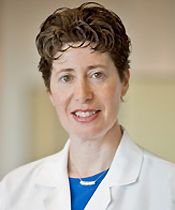Article
Actionable Mutations Common in Young Lung Cancer Patients
Author(s):
Most patients younger than age 40 with lung cancer had tumors with mutations that can be targeted with existing therapies.
Dr. Barbara Gitlitz, associate professor of Clinical Medicine at the University of Southern California in Los Angeles

Barbara Gitlitz, MD
Most patients younger than age 40 with lung cancer had tumors with mutations that can be targeted with existing therapies, according to a preliminary analysis of data from an ongoing study reported at the 2015 World Conference on Lung Cancer (WCLC).
In the study of tumor genomics in younger patients, 60 of the first 68 patients enrolled had adenocarcinoma. In patients with metastatic adenocarcinoma, who constituted the majority of participants, three-fourths of the tumors had actionable mutations.
The preliminary findings exceeded statistically derived expectations for discovery of actionable mutations in younger patients with metastatic adenocarcinoma, Barbara Gitlitz, MD, reported at the conference.
“We had a 33-year-old male who had a 7-month partial response and at progression, he had increased copy number, which is consistent with emergence of resistance in EGFR mutations, and the transformed mutations were also amenable to tyrosine kinase inhibition,” said Gitlitz, an associate professor of Clinical Medicine at the University of Southern California in Los Angeles.
The results came from the ongoing Genomics of Young Lung Cancer study, which aims to determine the genomic profile of lung cancers that occur in younger patients. Studies reported at the WCLC suggested that younger patients account for an increasing proportion of lung cancer incidence. The tumor genomics of that subgroup of patients has received little attention because younger patients historically constituted a relatively modest fraction of the total lung cancer burden.
Initiated a year ago, the study is enrolling patients at centers in the United States and Europe. Additionally, individuals can register for the study online and receive information about the nearest location that can provide the necessary genomic analysis.
Gitlitz said 30 of the first 68 study participants enrolled online and, in the process, helped expand the number of participating centers. Information about online enrollment is available at https:www.openmednet.org/site/alcmi-goyl.
Initially, the study’s primary objective was to obtain multicenter, prospective genomic data for primary lung cancer in 60 patients younger than 40, an accrual goal that has already been exceeded. With that information, investigators hope to gain insight into lung cancer biology associated with younger patients, as well as facilitate identification of new genome-defined subtypes of lung cancer, expand and speed access to targeted therapies for lung cancer, and provide data that will form the basis for future studies of lung cancer risk and associated genetics.
Investigators in the study have identified seven genomic alterations of interest: EGFR, KRAS, HER2, BRAF, ALK, ROS1, and RET. The focus on those mutations was decided on the basis of data from the Lung Cancer Mutation Consortium, an initiative of 16 major US cancer centers that contribute tumor-genomic information obtained from lung cancer patients treated at the centers.
“We felt that our enriched subtype would show an increase in targetable alterations from 35% to 50% and subsequent increase in use of targeted therapy,” said Gitlitz.
The data for the 68 patients enrolled thus far showed a median age at lung cancer diagnosis of 35 (range, 16-39), including 33 men and 35 women. Consistent with the literature on lung cancer, 88% (n = 60) of patients had adenocarcinoma, 10% (n = 7) had squamous-cell tumors, and one patient had small-cell lung cancer.
Gitlitz reported that 54 (79%) of the 68 patients had stage IV disease at diagnosis and the remaining patients had stages I-III. In the subset of patients with adenocarcinoma, 50 (74%) had stage IV disease at diagnosis.
Focusing on the 50 patients with stage IV adenocarcinoma, Gitlitz reported that genomic analysis showed that the driver mutation involved ALK in 22 (44%) patients, EGFR in 13 (26%), and ROS1 in three (6%) patients.
In five cases, data were insufficient to determine the driver mutation. The remaining seven (14%) patients had other types of mutations: EGFR-RAD1, EGFR Dup, HER2, ATM, BRCA2, p53/PTEN, and p53. Only one of these mutations occurred in a woman, suggesting a difference between men and women, as 90% of the women in the stage IV adenocarcinoma subgroup had tumors with ALK, EGFR, or ROS1 mutations.
Gitlitz BJ. The Genomics of Young Lung Cancer Study. Presented at: 16th World Conference on Lung Cancer; September 6-9, 2015; Denver, CO. Abstract 3632.
<<<








